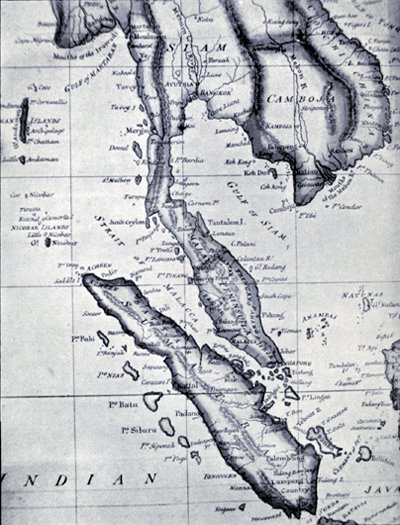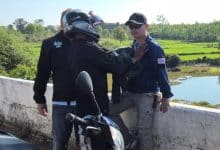Phuket History: The slow road to Bangkok

PHUKET: Towards the end of the 18th century, trade and logistics was tough business. Phuket, or Junk Ceylon, during that time was rich in tin, a semi-precious metal that was highly sought after by European and Indian traders.
Tin mining was therefore an important source of revenue for the island. Because tin mines in Junk Ceylon were considered government property, a large chunk of trade revenue had to be sent to the capital on a regular basis. In a time long before banks and money transfers, revenue collected in the form of silver, gold or bartered goods had to be physically transported to the capital to be handed over to the king.
A rare piece of document dated from around 1785 explained this process. It was mandated that tin revenues from Junk Ceylon and nearby towns, as well as merchandise imported from eastern India had to be transported to the capital on a regular basis.
18th century Siamese merchants used a route that started from Takua-Pa, a town just north of Junk Ceylon. Travelers and caravans would then pass through Khao Sok in Surat Thani, an area that is covered with thick tropical rain forest and steep hills even today. The caravans would have to penetrate the tropical jungle until they reached the Thaphanom canal.
From there government officials would arrange for the goods to be taken to Chaiya. The cargo of tin and other goods would then be transported by small boats sailing along a collection of small rivers and canals until it reached the Siamese capital in the central plains. Since the Ayutthaya period and up until 1785, the trail had also been used by merchants to transport goods to the capital and who wished to avoid sailing all the way around the Malay Peninsular to reach the Bay of Bengal.
In order to ship tin revenues from Junk Ceylon to the capital, the governor of Thalang would arrange to send the cargo up to Takua-Thung. The governor of Takua-Thung would then arrange to forward the goods to Takua-Pa so that it could be transported along the trail.
The overland route was used for many reasons. It was an old route that had been used for many years by merchants, since the ancient days when Takua-Pa, or Takola as it was then called, was still a thriving trade center. A network of deep canals had been dug so that merchandise could be transported by large boats to different towns.
The town of Chaiya on the Kra Isthmus was also a popular stop for merchants and traders. Using this route was hard, considering merchants had to transport their heavy cargo for miles overland through harsh terrain. But it remained the preferred route because sailing around the Malay peninsular was considered even more dangerous. Storms have, in the past, wrecked countless ships and opportunistic pirates infested the sea trade routes.
However in 1785, the Burmese invaded Siam and war broke out between the two kingdoms. Whilst Junk Ceylon managed to fend off the invaders, the ancient land route to the capital that had been used for centuries was cut off by Burmese troops that had taken over parts of the isthmus.
It soon became impossible to transport tin and other revenues from Junk Ceylon to the capital since major towns like Takua-Pa, Takua-Thung, Chaiya and Chumporn had fallen under Burmese control. Stocks of tin, fabrics from India and an array of weaponry bound for the capital began to pile up at the Khao Sok pass for years. Much of the cargo was lost, damaged or stolen during this time.
After the war, King Rama I wanted to establish a new trade route from the South to Bangkok. He asked Phraya Surintharaja, a high ranking noble to find a new shipping route that would connect the south-west coastal towns with the capital.
Phraya Surintharaja was the governor of eight coastal towns in the south of Siam, including Thalang (Junk Ceylon), Takua-Pa and Takua-Thung, so he knew the geography of the area quite well. These towns made up a major part of the old route.
The arrival of the Portuguese, Dutch and English also meant that sea voyages were becoming safer and more advanced and were utilized to a greater extent.
Initially Phraya Surintharaja was asked by King Rama I come to Bangkok to meet with him. There the king told him that a high ranking minister had just passed away and that he wanted Phraya Surintharaja to take the vacant position.
Although highly honored, Phraya Surintharaja did not want to stay in Bangkok and he told the king that he would lead a happier life if he was allowed to remain as the king’s viceroy in the southern coastal towns.
In return, he promised King Rama I that he would open a new trade route that would connect the southern towns of Siam with Bangkok. The king agreed and Phraya Surintharaja set out to plan the new route. He asked the king to grant him the use of ten elephants from Nakhon-Si-Thammarat and another ten from Chaiya, in addition to a large workforce that he recruited from the nearby villages. The king approved of his request and the large project to clear a new route to Bangkok was underway.
The new route that Phraya Surintharaja built was a much needed replacement to the old one that had been in use for centuries. Using the new route, it only took three days for goods to reach Bangkok from the south.
The journey was also much easier and less prone to sudden flash floods that had in the past destroyed a lot of precious cargo. The new route not only allowed for easier transportation to the capital, it also made the administration of the southern provinces easier and more effective.
— Anand Singh
Latest Thailand News
Follow The Thaiger on Google News:


























